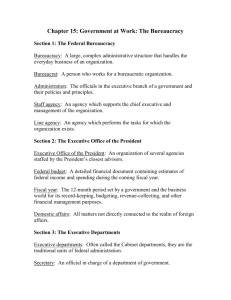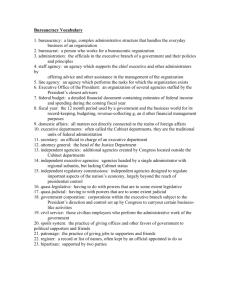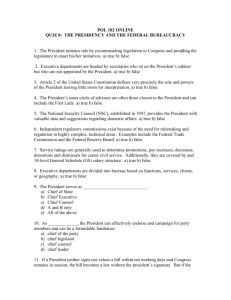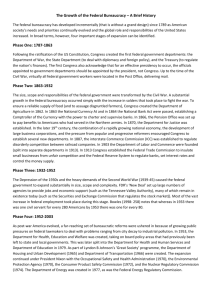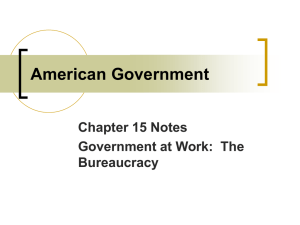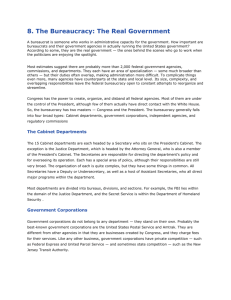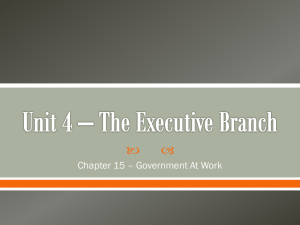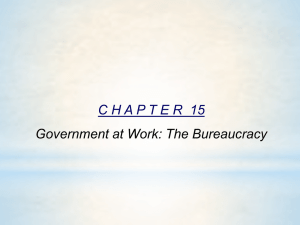CHAPTER 15: THE BUREAUCRACY
advertisement
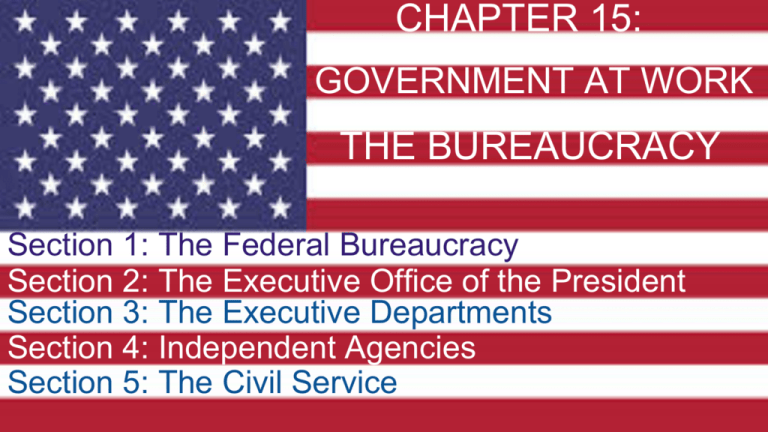
CHAPTER 15: GOVERNMENT AT WORK THE BUREAUCRACY Section 1: The Federal Bureaucracy Section 2: The Executive Office of the President Section 3: The Executive Departments Section 4: Independent Agencies Section 5: The Civil Service SECTION 1: THE FEDERAL BUREAUCRACY ➢ BUREAUCRACY - a large, complex administrative structure that handles the everyday business of an organization. ○ What does the federal government do as an administrative structure? ■ Deliver mail ■ Regulate business practices ■ Collect taxes ■ Conduct foreign policy ■ Administer Social Security THE FEDERAL BUREAUCRACY ➢ Many believe that it suggests ○ Red tape ○ Waste ○ Delay ■ Bureaucracy is used as an organized and efficient way to conduct business. ● What are some types of bureaucracy in the private sector ○ 3 Features ■ Hierarchical Authority ■ Job Specialization ● BUREAUCRAT - person who works for organization with certain responsibilities and duties. THE FEDERAL BUREAUCRACY ➢ What are the benefits? ○ Allow people to work together ○ Can reduce conflicts ○ Gain specialized skills ○ Allow for easy transition ■ Employees leave, new employees hired ○ Hold appointed positions ■ They are not elected - private sector ○ Democracy - depends on elected officials running the bureaucracy THE FEDERAL BUREAUCRACY ➢ Almost all bureaucracy is located in the executive branch. ○ Article II of the Constitution suggests executive departments. ■ Anticipates the creation of two departments ● Military and Foreign Affairs ○ ADMINISTRATION - the officials in the executive branch of government and their policies and principles. ■ Framers realization that without people the laws of Congress would be just words and phrases THE FEDERAL BUREAUCRACY ➢ The term department is saved for those in the President’s cabinet. ○ All others are known as - agency, administration, commission, corporation, and authority ■ Agency - refers to governmental bodies (EPA) ■ Administration - government bodies (NASA) ■ Commission - business regulation (FCC) ■ Corporation and Authority - conduct business activities - Federal Deposit and Insurance Corporation THE FEDERAL BUREAUCRACY ➢ 2 types of administration ○ Staff Agencies - aid the chief executive and other administrators by offering advice and other assistance in the management of the organization ○ Line Agencies - actually perform the tasks for which the organization exists. ■ Line agencies are given goals to meet by Congress and President ■ Staff agencies help line agencies meet those goals. Section 2: The Executive Office of the President ➢ Jefferson paid his employees out of his pocket ○ 1857 changed that ➢ EXECUTIVE OFFICE of the PRESIDENT organization of several agencies staffed by the President’s closest advisors ○ Staffed by Congress in 1939 ➢ Nerve Center is the White House Office ○ President’s key personal and political staff ■ Most held in the two wings on either side of the White House ● Most (West) Oval Office - Few (East) Tours The Executive Office of the President ➢ National Security Council (NSC) ○ Meet on short notice ○ President is the chair ○ Discuss matters pertaining to ■ Domestic ■ Foreign ■ Military ● Members ○ VP ○ Secretary of State and Defense ○ Director of CIA ○ Chairmen of the Joint Chiefs of Staff The Executive Office of the President ➢ Newest Agency ○ Developed following 9/11 ○ Purpose is to advise President on matters relating to the security of the country. ➢ Office of Management and Budget ○ ○ ○ ○ Largest and most influential after White House Office Headed by an appointee Required to prepare a national budget Federal Budget - very detailed estimate of receipts and expenditures, and an anticipation of federal income and outgo during next fiscal year. The Executive Office of the President ➢ Office of Policy Development ○ Advises President on all matters relating to domestic affairs. ○ Domestic Affairs - all matters not related to the realm of foreign affairs. Section 3: The Executive Departments ➢ Executive Departments - traditional units of federal administration, and each of them is built around some field of activity. ○ Created three departments in 1789 ■ Department of State ■ Department of Treasury ■ Department of War ● ● Departments were added over the years based on the constantly growing workload of the government New departments replaced old or encompassed those departments The Executive Departments ➢ Chief Officers and Staff ○ Secretary - head of a department ○ Attorney General - head of the Department of Justice ■ Department heads serve in the President’s cabinet ■ Link between Presidential policy and their department ○ Departments are divided into Subunits ■ Made up of Staff and Line Agencies ● Have focuses on separate issues within the department ■ Vary in terms of visibility, size, and importance The Executive Departments ➢ The Cabinet ○ Informal advisory body to the President ○ Product of custom and usage ○ 1789 Four departments ■ Washington consistently used them ■ Became permanent positions ■ Now consists of 15 departments ○ Cabinet members ■ Chosen by President ■ Approved by Senate ● ● Party affiliation Qualifications and experience The Executive Departments ➢ Women and Minorities ○ Just starting to take a more active role ■ First woman cabinet member ● Frances T. Perkins - Secretary of Labor ○ Appointed by Franklin Roosevelt ● Ford administration ○ Woman and African American in cabinet ➢ Cabinet’s Role ○ 2 Job’s ■ Administrative head of an executive department ■ Advisor to the President Section 4: Independent Agencies Objectives: 1) Explain why Congress has created independent agencies. 2) Identify the characteristics of independent regulatory commissions. 3) Describe the structure of government corporations. Independent Agencies ❏ Prior to 1880 most of the work completed in the executive branch was done so through the cabinet positions. ❏ Independent Agencies - additional agencies created by Congress but located outside of the departments. ❏ NASA / SSA ❏ Why? Numerous reasons ❏ Do not fit in any department ❏ To protect from partisan and pressure politics Independent Agencies ❏ Independent Executive Agencies ❏ Independent Executive Agencies - headed by a single administrator with regional subunits, but lacking Cabinet status. ❏ Some are large ❏ GSA, NASA, and EPA three of the largest ❏ Operate much like cabinet positions ❏ Single administrator ❏ Subunits ❏ Operate on a regional basis ❏ Most important difference - no cabinet status Independent Agencies ❏ Other agencies ❏ ❏ ❏ ❏ Civil Rights Commission Peace Corps Federal Election Commission National Transportation Safety Board ❏ Much smaller agencies, still have important jobs. ❏ American Battle Monuments Commission ❏ Citizen’s Stamp Advisory Committee ❏ Migratory Bird Conservation Commission ❏ Seldom seen or heard. Independent Agencies ❏ Independent Regulatory Commission designed to regulate important aspects of the nation’s economy. ❏ Created by Congress ❏ Largely beyond the reach of the President ❏ Headed by a board or commission ❏ 5 to 7 members ❏ Appointed by President ❏ Must be bipartisan ❏ Appointed for terms (staggered) Independent Agencies ❏ Quasi-Legislative - powers that are related to legislative. ❏ Make rules and regulations ❏ Securities and Exchange Commission ❏ Provide details for borrowing of money, stocks, bonds, and etc.... ❏ Quasi-Judicial - powers that are to some extent judicial. ❏ Decide disputes for which they are granted power. ❏ Securities and Exchange Commission ❏ ❏ Investigates reports of fraud or scandal Cases can be taken to U.S. courts of appeals. Independent Agencies ❏ Government Corporations - are within the executive branch and subject to the President’ s direction and control. ❏ Were used very little until WWI and depression ❏ 50+ organizations today ❏ What was the first? Bank of the United States (1791) ❏ Run by board of directors ❏ GM directing operations ❏ Income goes back into business ❏ Congress decides reasoning for public agencies ❏ What they can do. Section 5: The Civil Service Objectives: 1) Describe the development of the civil service. 2) Identify characteristics of the civil service as it exists today. 3) Analyze the restrictions on the political activities of members of the civil service. The Civil Service ❏ Civil Service - composed of those civilian employees who perform the administrative work of government. ❏ How many? ❏ Of those 300,000 work in D.C. area ❏ President appoints approximately 2500 positions ❏ Again Article II of the Constitution ❏ Washington and Adams appointed with party ❏ Jefferson realized to appoint to office not only must they be qualified and experienced but have political acceptance. ❏ Spoils System - the practice of giving offices and other favors of government to political supporters and friends. ❏ 1829 Jackson dismisses 200+ presidential appointees and 2000 officeholders. Why? ❏ Replaced them with people he wanted. ❏ Patronage - the practice of giving jobs to supporters and friends. ❏ 4 Reasons (Jackson) ❏ ❏ ❏ ❏ 1) duties are simple - anyone with intelligence can do it. 2) there should be a rotation in office. 3) long service can lead to tyranny and inefficiency. 4) people are entitled to have the party they put in office in control The Civil Service ❏ A need for change. ❏ Many sought change but could not accomplish it. ❏ No change took place until events in 1881 ❏ President Garfield ❏ Fatally shot by office-seeker ❏ President Arthur assumes office ❏ Gets the Pendleton Act passed. ❏ Establishes the Civil Service System ❏ Pendleton Act - established the means for office. ❏ quality of one’s work ❏ hiring / promotion / personnel actions The Civil Service ❏ First goal of civil service reform ❏ Elimination of spoils system ❏ New system recruiting and keeping best qualified in federal work force. ❏ Most are hired through a competitive process now ❏ Paid and promoted based on written evaluations ❏ Protected from disciplinary or dismissal actions ❏ party lines The Civil Service ❏ Office of Personnel Management ❏ Federal government’s central personnel agency ❏ Independent agency in executive branch ❏ Headed by single person appointed by President ❏ Responsibilities ❏ ❏ ❏ ❏ ❏ Federal recruiting Examining Hiring process Maintain registers Registers - lists of those applicants who pass its tests and are qualified for employment. The Civil Service ❏ Merit Systems Protection Board ❏ Enforces the merit principle in federal bureaucracy ❏ Board is bipartisan ❏ Bipartisan - it includes members from both parties. ❏ 3-member panel picked by President and Senate ❏ Hears appeals from federal employees ❏ denial of pay increases ❏ demotions ❏ firings
